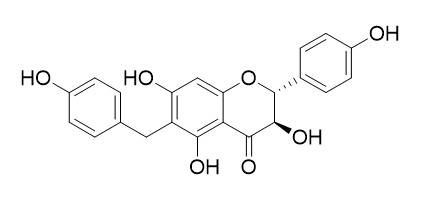Gericudranin E
Gericudranin E shows significant hepatoprotective effects with the EC50 value of 39.87+/-0.7 microM.
Inquire / Order:
manager@chemfaces.com
Technical Inquiries:
service@chemfaces.com
Tel:
+86-27-84237783
Fax:
+86-27-84254680
Address:
1 Building, No. 83, CheCheng Rd., Wuhan Economic and Technological Development Zone, Wuhan, Hubei 430056, PRC
Providing storage is as stated on the product vial and the vial is kept tightly sealed, the product can be stored for up to
24 months(2-8C).
Wherever possible, you should prepare and use solutions on the same day. However, if you need to make up stock solutions in advance, we recommend that you store the solution as aliquots in tightly sealed vials at -20C. Generally, these will be useable for up to two weeks. Before use, and prior to opening the vial we recommend that you allow your product to equilibrate to room temperature for at least 1 hour.
Need more advice on solubility, usage and handling? Please email to: service@chemfaces.com
The packaging of the product may have turned upside down during transportation, resulting in the natural compounds adhering to the neck or cap of the vial. take the vial out of its packaging and gently shake to let the compounds fall to the bottom of the vial. for liquid products, centrifuge at 200-500 RPM to gather the liquid at the bottom of the vial. try to avoid loss or contamination during handling.
Proc Biol Sci.2024, 291:20232298.
J Ethnopharmacol.2020, 260:112988.
Planta Medica International2022, 9(01):e108-e115.
Metabolites.2023, 13(6):689.
J. Traditional Thai Medical Res. 2022,8(1):1-14.
J Pharm Biomed Anal.2019, 164:119-127
Mediators Inflamm. 2016, 2016:6189590
University of East Anglia2023, 93969.
Nutr Cancer.2023, 75(1):376-387.
Molecules.2021, 26(2):313.
Related and Featured Products
Biol Pharm Bull. 2006 Apr;29(4):838-40.
Hepatoprotective compounds of the roots of Cudrania tricuspidata on tacrine-induced cytotoxicity in Hep G2 cells.[Pubmed:
16595932]
METHODS AND RESULTS:
The bioassay-guided fractionation of the MeOH extract of the root barks of Cudrania tricuspidata furnished three hepatoprotective compounds, gerontoxanthone A (2), cudraflavone B (4), Gericudranin E (5), together with four prenylated xanthones, cudraxanthone B (3), isocudraxanthone K (6), cudraxanthone C (7), cudraxanthone H (8), and a prenylated flavanone, euchrestaflavanone C (1).
CONCLUSIONS:
Compounds 4 and 5 showed significant hepatoprotective effects with the EC50 values of 37.39+/-0.4 and 39.87+/-0.7 microM, respectively, and compound 2 showed moderate hepatoprotective effect with an EC50 value of 125.9+/-1.5 microM, against tacrine-induced cytotoxicity in Hep G2 cells.
Silybin as positive control showed an EC50 value of 84.76+/-0.5 microM. Isocudraxanthone K (6) is a new compound.
Natural Product Sciences, 2010, 16(2):75-79.
Monoamine oxidase inhibitory flavonoids from the root bark of Cudrania tricuspidata.[Reference:
WebLink]
METHODS AND RESULTS:
Two new benzylated flavonoids, 5,7,4′-trihydroxy-6-p- hydroxybenzylflavanone (1) and 5,7,4′-trihydroxy-6,8-di-p- hydroxybenzylflavanone (2) together with six known flavonoids, kaempferol (3), artocarpesin (4), cycloartocarpesin (5), cudraflavone D (6), Gericudranin E (7), and leachianone G (8) have been isolated from the root bark of Cudrania tricuspidata. The structures of 1 and 2 were characterized based on spectroscopic data including 1D- and 2D-NMR. All the isolates were evaluated for their inhibitory effects of monoamine oxidase (MAO).
CONCLUSIONS:
Among them, kaempferol (3), artocarpesin (4), and cudraflavone D (6) showed moderate inhibitory effects with IC50 values of 82.3, 30.8, and 71.8 μM, respectively.



